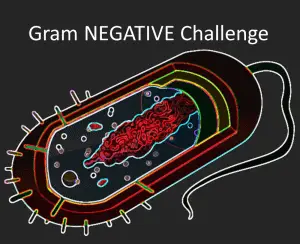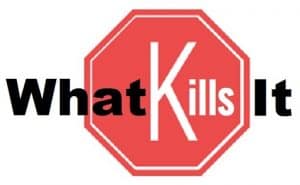Do you enjoy the thought of bacteria crawling around on your food, your skin and the surfaces in your home? Of course you don’t! No one does.
In this article, we will explore what gram negative bacteria are, what diseases they cause, how they get classified, and finally, what you can use to kill gram-negative bacteria.
What Are Gram Negative Bacteria?
Gram negative bacteria are found everywhere in our homes, offices, grocery stores and more. They pose a major public health threat due to their high resistance to most cleaners and antibiotics. Whether they are in your food or on your bathroom counter, they can cause issues for you and your family.
In general, all bacteria can be divided into two categories: Gram Positive and Gram Negative –
Gram Positive Bacteria have a thick outer membrane. Think of it as skin. And since their skin is so thick and porous, they can absorb lots of detergents and chemicals, which kill them very quickly.
Gram Negative Bacteria have a very thin outer membrane with multiple layers of membranes underneath. This means that it does not absorb cleansers or detergents very easily and therefore have a high resistance to them. It means they are much harder to kill.

Fun Fact: To determine their category, a specimen is flooded with a kind of pigmentation dye. If the dye can stain the bacteria blue, the test result is “positive” (Gram-Positive). If the bacteria does not stain blue, then the test result is “negative” (Gram-Negative).
What Diseases Are Caused by Gram Negative Bacteria?
The family of gram negative bacteria includes a variety of different bacteria. Each of these bacteria cause a different type of illness. A few of the most common are as follows:
Escherichia Coli: Better known as the infamous E. Coli. This bacterium is a well-known cause of urinary tract infections, severe food poisoning and meningitis. It is a food-borne illness, meaning people contract it by consuming contaminated food or water. We wrote a series on E.Coli you can read here.
Pseudomonas aeruginosa: This one usually causes urinary tract infections, but can also cause pneumonia. It can be particularly dangerous for people with compromised immune systems.
Salmonella: Salmonella affects the intestinal tract and causes severe diarrhea. It is most commonly spread through infected food and water.
Yersinia pestis: This bacterium is more commonly known as the plague. I know that sounds dramatic, but the plague is still a real thing. It is contagious and can be spread through droplets from a sneeze or a cough. Initial infection usually occurs when a human is bitten by a flea who is carrying the disease.
What Can Kill Gram Negative Bacteria?
For the purpose of this discussion, we will break it into two scenarios: the bacteria being either outside or inside of your body. If it’s outside your body, it is likely living on surfaces in your environment and needs to be killed with a real disinfectant.
If the bacteria is inside your body, you are likely feeling very ill. You’ll need to see a doctor and get some for a thorough evaluation and course of treatment, so we will not discuss this scenario…because we are not doctors.
Cleaners That Can Kill Gram Negative Bacteria:
When trying to disinfect various surfaces, it is important to know the difference between “clean” and “disinfected”. For example, you can wipe the whole kitchen down with a damp cloth and make it look clean. But it won’t really be disinfected, which is what you’re actually trying to accomplish.
Here are some cleaners you can use to kill bacteria such as E. coli, salmonella and the other illnesses listed above:
Bleach: (Sodium Hypochlorite) That’s right! Good old-fashioned bleach is a great way to kill gram-negative bacteria. You can purchase pure bleach, put it in a spray bottle and dilute it using the manufacturer’s instructions on the label. You can also purchase cleaners with bleach in them that have already been appropriately mixed with water and other ingredients. Read the label of some of your favorite brands to see if they contain bleach.
Disinfectant Wipes: Most household disinfectant wipes contain ingredients that will kill gram-negative bacteria, BUT the surface must remain wet for 4-10 minutes, depending on the wipe. Anyone who’s ever used a cleaning wipe knows that the surface does NOT remain wet that long. If you choose this option, read the contact time BEFORE buying. Some wipes are 1 minute, vs. 10 minutes.
Rubbing alcohol: Both ethyl and isopropyl alcohol (think hand sanitizers) are effective in killing gram negative bacteria. You can simply pour some on a towel or cloth and wipe down all your surfaces.
The alcohol usually kills the bacteria very quickly, but it could take up to ten minutes, depending on how much bacteria there are. I like to error on the side of letting it sit just a bit longer to make sure it kills everything. You can also put the alcohol in a spray bottle to allow you to cover more surface area and let it sit for a few minutes before wiping it off.
White Vinegar: If you must go with a more environmentally-friendly solution than bleach, try regular vinegar. Vinegar can be used on a variety of surfaces to kill all kinds of germs, including E. coli and salmonella. Spray surfaces and keep it wet, then wipe down all the surface areas after cleaning, degreasing, etc. Since vinegar is NOT a registered pesticide, there won’t be reliable instructions.
Important Factors in Killing Bacteria
As mentioned, it is possible for surfaces to look clean, but not be disinfected. When trying to achieve “Disinfection” in your kitchen, bathroom or other areas of your home, consider the following tips and tricks:
Clean First, Then Disinfect: If you’re cleaning up a messy kitchen that includes grease or other substances from cooking, those substances will get in the way of the disinfectant. They can actually hinder it from doing its job. Be sure to clean all your surfaces first with soap and water, degreaser or whatever cleaner you prefer for those jobs.
After all the dirt, grime and soil is gone, you can proceed with disinfecting your surfaces. This is as simple as putting the disinfectant of your choice on a towel, cloth, (or mop if you’re doing the floor) and wiping everything down.
Consider the Temperature of Your Food: Most food-borne illnesses can be prevented by making sure your food is stored at the proper temperatures and cooked at the proper temperatures. According to the United States Department of Agriculture (USDA), the “danger zone” for food is between 40 and 140 degrees Fahrenheit.
The USDA recommends storing your food at a temperature or 40 or below is ideal to prevent rapid growth of bacteria. It will not necessarily kill the bacteria, but it will keep it from growing. The ideal fridge temperature is between 35-38 degrees Fahrenheit.
Cooking your non-meat food items or leftovers to 145 degrees Fahrenheit or higher will help to kill harmful bacteria and keep your family safe from food-borne illnesses.
Avoid Cross-Contamination: Wash your hands frequently when handling food, dirty laundry or diapers and other such items. You should also wash your hands after using the restroom, and ask your family to do the same.
The simple practice of washing your hands frequently can significantly decrease the spread of bacteria and germs in your home or office. Be sure to read the label before purchasing hand soap. Find one that is anti-bacterial so you know it works on bacteria!
Conclusion:
Gram negative bacteria can cause serious illnesses for your family if you don’t take the proper precautions. It is more resilient than Gram-positive bacteria and doesn’t die as easily.
However, choosing the right disinfectants and following the simple guidelines outlined above can make your home safer and cleaner for you and your family.
